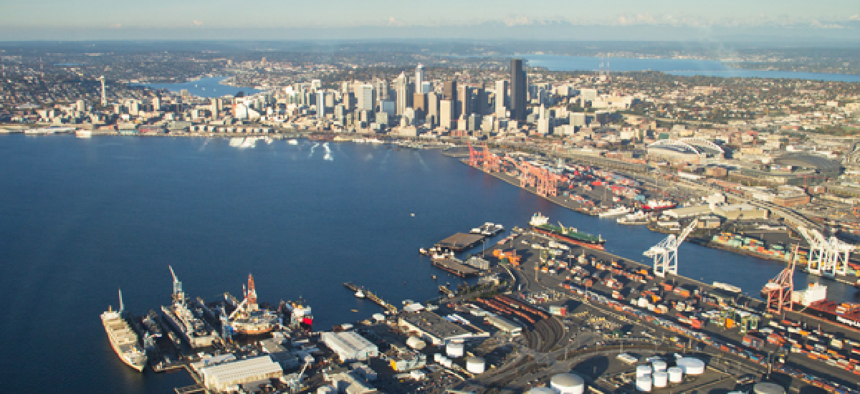How the Port of Seattle crafted a hybrid approach to GIS

Using both Esri and open-source Boundless GIS saves the port money and reduces its business risk.
Having options is a good thing. At least, that’s what Eric Drenckpohl, enterprise geographic information systems manager for the Port of Seattle, was thinking he decided to give the open-source Boundless GIS a try.
“There is something to be said for having as many different tools in the toolbelt running both proprietary and nonproprietary code,” Drenckpohl said. So when he decided it was time to develop a new version of Port Explorer -- an internal, web-based GIS application that includes most of the datasets used by the port’s various departments -- he turned to Boundless GIS, an open-source offering.
Drenckpohl said he’d been following open-source GIS for some time, and when the security agencies in the government finally “sort of blessed it,” he decided it was time to give it a try.
“We didn’t need to disrupt or dismantle any of our existing GIS systems,” he said. “We were able to just use [Boundless] for this new GIS project that we would normally have used Esri ArcGIS server for.”
Since the basic Boundless software was free to use, Drenckpohl could develop and deploy it alongside Esri without running into budget issues. That was critical. “We could do this is a one-off, and if we didn’t have a great experience with it, that would just be it,” he said.
As it turned out, Drenckpohl said the Boundless software “has met our needs exceptionally well.” In fact, he added, “We are probably a pretty good client for Boundless because we’ve never called them for help or had to file a bug fix.”
The most obvious advantage to using a supported open-source GIS platform is cost. Boundless charges for support and training, as well as access to premium content and services through its Boundless Connect subscription service. Additionally, the company provides a full-featured, supported professional desktop program, Boundless Desktop, which is available with no licensing fees or contracts.
The other major plus, Drenckpohl said, is customizability. “The big thing you get from open source -- at the price of writing code -- is flexibility,” he said. “There are a lot of Esri modules, like their Sharepoint module, that are pretty easy to implement [but] are very much locked down,” he said. “That’s the price you pay to be up and running quick.”
At least for the near future, Drenckpohl said the port will use open-source tools alongside its Esri software on a case-by-case basis. For some projects, the port is using open-source all the way back to its PostGIS database. Even then, however, Drenckpohl has opted to use Latitude Geographics’ GeoCortex Essentials as its web app development platform. “It does save you some coding on the front end,” he said.
Drenckpohl also noted that Boundless GeoServer, a cloud-based geospatial server, works well with the port’s Esri backend data sources. As a result, the port did not have to move its large raster database of historical aerial photography from its ArcSDE repository.
For other projects, Drenckpohl said the port will continue to use Esri tools.
In developing a new version of its Stormwater GIS program -- designed to support the port’s stormwater management plan -- Drenckpohl decided to use Esri for the back end because of its flow-tracing capabilities. Replicating that feature in Boundless, he said, would have required custom coding.
Going forward, Drenckpohl said he will choose GIS development and deployment software on a case-by-case basis. “A lot of times the tiebreaker will be the open source,” he said. “If both platforms will do it, it would be kind of silly not to do it with Boundless.”
At the same time, Drenckpohl said there are good reasons for keeping Esri in his toolset. “If we were to pull the plug on Esri, we would obviously have a big backlog of development projects to re-create those Esri legacy systems,” he said. “There are a lot of sleeping dogs that are lying there quite nicely serving their purposes.”
The bottom line, Drenckpohl said, is that bringing open-source tools into his GIS development toolset is a welcome protection against the uncertainties that go along with dependence on a single, proprietary software provider.
“As an enterprise GIS manager, I’m pretty alarmed with some of the licensing directions that Esri has hinted that they might want to go in,” Drenckpohl said. Specifically, he is concerned that Esri is moving toward a subscription model. “Renting software just drives me crazy. I can’t manage 1,800 different employee logons to try to figure out their rights and privileges and what costs they might incur,” he said.
Esri offers both subscription pricing and regular licensing. “It’s not like we’re going one versus the other,” S.J. Camarata, Esri’s director responsible for corporate strategy, told GCN. “We are not only going to be a subscription company. We’re not dumping all of our regular licensing and only going subscription.”
Camarata also stressed that Esri is not against open-source programs, and has worked hard to make its systems interoperable. “There is definitely value in some open-source code,” he said. “We actually work quite a bit with open source and open data and open standards. We publish a lot of open code into the marketplace.”
Still, Drenckpohl said he feels better having Boundless as an option. “Now I feel like I have a very viable alternative that reduces business risk for the Port of Seattle,” he said. We’ve got “the best of both worlds running this sort of hybrid environment.”





